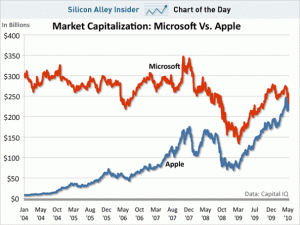In the Metric of the Week posts, we’ll cover different metrics that you’ll hear about when investing. We’re starting off with the basics. Previously, my friend John covered the price-to-earnings ratio and earnings per share. This week, I’ll talk about another important basic: market capitalization.
The concept of market cap is really quite simple. It is the market value of the publicly traded securities of that company. However, investors more accurately look at it as the total value of the company itself. The formula is simple:
Number of Shares Outstanding times Price per share = Market Cap
The number of shares outstanding is pretty easy to find for any publicly traded stock. Go to Google Finance, enter the ticker symbol, and you’ll see it right up top:
The next component is the price per share. In the example above, that is $612.00 per share. Multiply these two figures and you arrive at the Market Cap. For Google (GOOG) right now, that is $195.70 billion. Easy enough, right? That’s really all there is to it.
What is market cap useful for?
Market cap is one way to classify companies by size. There are typically three separate categories:
- Large Cap: A company with a market cap greater than $5-20 billion
- Mid Cap: market cap between $1 and $5 billion
- Small Cap: below $1 billion

There are sometimes further designations, such as Micro Cap, but these three are suitable for our purposes. Knowing the difference is helpful when analyzing mutual funds you want to invest in. Why? Because the risk and return profile for each of these categories can be very different. Depending on the year, small cap companies generally outperform mid and large cap stocks, but they come with a higher degree of risk. This is because they are often younger companies with less established profitability. Large cap stocks, on the other hand, generally include the companies everyone knows about: Pfizer, GE, Exxon, etc. These companies have usually been around for a lot longer, and generally have consistent profits. As a result, investors don’t expect to be compensated as highly for the risk they take.
In essence, the main takeaway is that market cap is a quick way to determine how big or small a company is and what kind of risk/return profile it will have.
–
Have any questions? Leave them below in the comments section! (Email readers need to come to the site)
